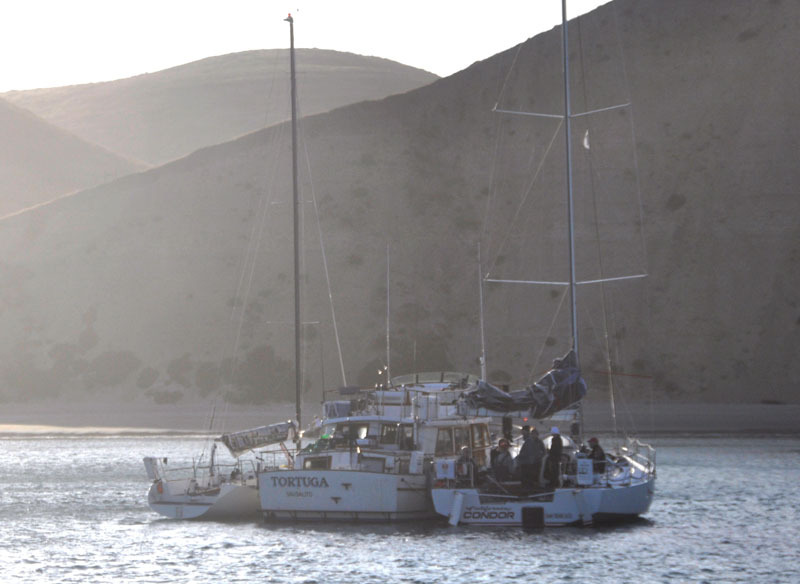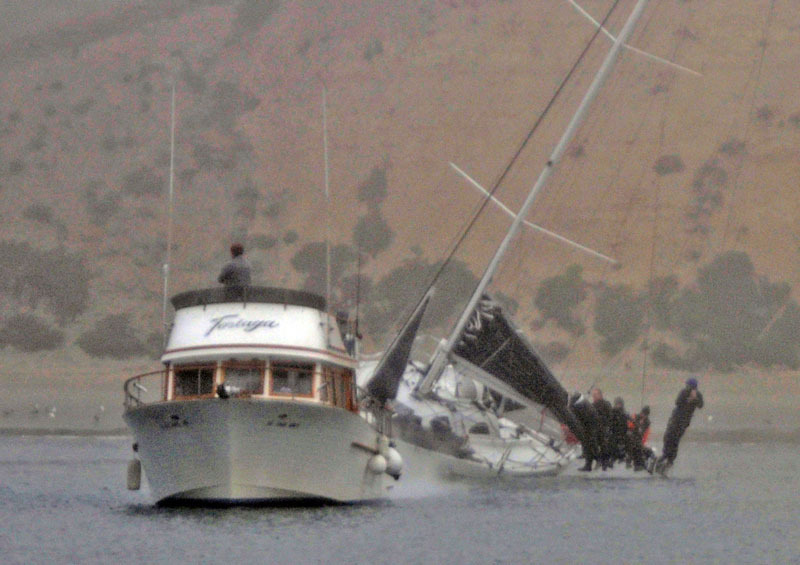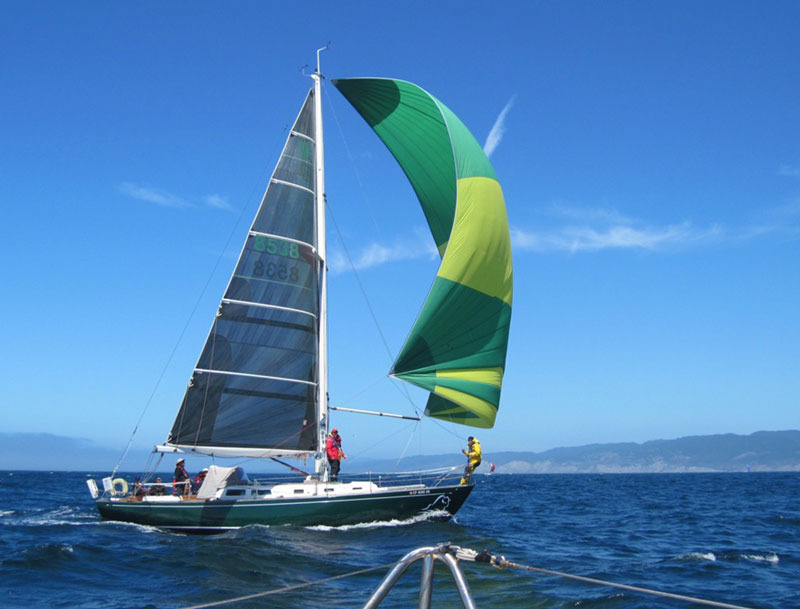
High and Dry in Drake’s Bay
Last weekend’s Drake’s Bay Race, a two-day event that combined OYRA and Singlehanded Sailing Society fleets, saw more wind than in the past few years. After racing from the Corinthian Yacht Club in Tiburon up to the finish off Point Reyes, boats anchor and/or raft up to spend the night and then race back the next day. The Richmond YC-based Antrim Class 40 California Condor sailed in a full-crew OYRA division.

"California Condor had a successful race to Drake’s Bay on Saturday," reports the boat’s skipper, Buzz Blackett. "But after that our good karma and my good judgment disappeared. After finishing, we spent the next 2.5 hours trying to set our Fortress FX 23 anchor; dragging, harvesting kelp, moving and repeating. We finally decided to set the anchor closer to shore, out of the big breeze, in 11 feet of water, where there were some sandy, kelp-free bottom patches. It worked, and we paid out almost all of our 220 feet of rode to raft up with the trawler Tortuga, the Mancebo 31 Bloom County and the Express 27 Bombora for a fun cocktail hour and dinner.

"My theory was that the northwest wind would continue to hold us off the shallower water as the tide went out. Wrong! The wind went soft and clocked briefly to NNE. By the end of the evening we were softly aground. We tried briefly to move with Tortuga’s help while still rafted up, and then again after Tortuga and Bloom County split off, but we didn’t get anywhere.
"My new theories were that we wouldn’t move as long as we were aground, and that the tide would come back in and we’d be able to float off, aided by the wind. Wrong again! We were firmly aground at 2:30 a.m., with everyone on Tortuga and other boats fast asleep. OK, we’d get help when the sun came up. At 5 a.m., the boat heeled over to port and the dawn light showed the shore was closer. OMG. We must have been gently bounced in by the tiny south-to-north swell. With the water getting shallower by the minute, we kept heeling more and more as we tried to free ourselves. Jib up, all crew on the boom to leeward, one person on the leeward spinnaker halyard, max engine. Nada. Tortuga tried valiantly for over an hour to pull us off. Ixnay. Finally, at 8 a.m., I accepted that there was no chance to get off before the high tide in the early afternoon. Further effort before that would only damage the boat.

"At 1 p.m., we put the jib up, kedged with the anchor, got free, and had a nice sail back. Everybody got to drive. The only apparent damage to the boat was the loss of the fiberglass tail on the keel bulb — a relatively simple repair.
"A big thanks to Charles and Elliott James and Jon ‘Chewey’ Stewart on Tortuga for all of their able assistance. And thanks to all the sailors and the race committee who swung by to offer food, water and help.
"I’d love to know how other boats managed to set their anchors through the kelp.
"Our grounding could have been a disaster. We were very lucky. Magical thinking doesn’t work in anchoring!"

We’ll have more on the Drake’s Bay Race and resulting incidents in the September issue of Latitude 38, and we’ll also feature a cruising guide to points just a bit farther up the coast — Tomales and Bodega bays.
The Ice Cocktail Challenge
In a ‘Lectronic Reader Submission from earlier this month, Janet Baker asked what we thought was an improbable question: "Have you ever had glacial ice in your whiskey?" The gauntlet thusly thrown down, we had a quick response from David Eberhard and Deborah Connors of San Francisco.
"You asked if we’d ever had glacial ice in our whiskey. The answer to that is no," David wrote, "but we had it with our rum and cokes on many occasions last summer." The couple went cruising in Alaska in 2016, and sent us a few photos of their trip onboard Valkyrie, a Roberts 44.
.jpg)
"We would often lasso a small bergy bit and haul it aboard. Not only is the ice very hard and long-lasting, but it is crystal clear. In the sunlight it sparkles as though it is diamonds. It’s very beautiful."
.jpg)
The couple did do some sailing as well: "The photos only start to explain what last summer was like for us. There is so much more to the adventure than pictures of ice. The navigational challenges include timing to run tidal rapids so you don’t get caught in currents that can be in excess of 12 knots."

Also challenging was "picking out an anchorage when your daily tidal range can be 20 to 24 feet. Anchoring included frequent shore lines to trees. These are just a few of the many things we discovered last summer in Alaska. It was a challenging summer, but worth every minute of it."
.jpg)
Do you have great pictures or a great story? Please send them here.

